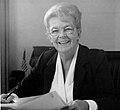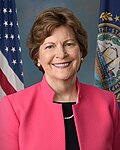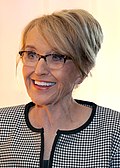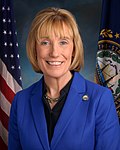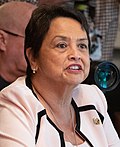Top Qs
Timeline
Chat
Perspective
List of female governors in the United States
Women who have served as governor of a U.S. state From Wikipedia, the free encyclopedia
Remove ads
As of 2025, 51 women have served as governor of a U.S. state, three as governor of an unincorporated U.S. territory, and two as mayor of the District of Columbia. In January 2025, women have been serving as governor in 12 U.S. states (13 between January 7 and 9, and January 21 and 25; 14 between January 9 and 21), as mayor of the District of Columbia, and as territorial governors of Guam and Puerto Rico. Of the current female state governors, 8 are Democrats and 4 are Republicans. Madeleine Kunin is the oldest living former female governor at 91.

Male
Female
Remove ads
History
Summarize
Perspective

1
2
3
4
5
The first woman to act as governor was Carolyn B. Shelton, who served as Acting Governor of Oregon for one weekend from 9 a.m. on February 27, through 10 a.m. on March 1, 1909. The outgoing governor, George Earle Chamberlain, had been elected to the U.S. Senate and had to leave for Washington, D.C., before his term ended; the incoming governor, Frank W. Benson, had become ill and could not assume office early. Chamberlain left Shelton, his secretary, in charge for the weekend.[1] It was another three and a half years before women were allowed to vote in Oregon.[2][a]
The first woman acting governor to be entrusted with substantial duties while in office was Soledad Chávez de Chacón, who held the powers and duties of Governor of New Mexico for two weeks in 1924 while Governor James F. Hinkle attended the Democratic Convention in New York. Lieutenant Governor José A. Baca had died in May, so Chacón, the Secretary of State, filled the position. Chacón said that she believed that her 1924 elevation was the first time in the United States that a woman had been called on to assume the responsibilities of the governor.[4]
The first woman to assume office as governor pursuant to a special election was Nellie Tayloe Ross of Wyoming, who was elected on November 4, 1924, following the death of her husband and former governor, William B. Ross, and was sworn in on January 5, 1925.[5] Wyoming was the first state to provide women's suffrage[6] after New Jersey had abolished it in 1807. Miriam A. Ferguson of Texas won the general election of November 3, 1924, and was sworn in on January 20, 1925. Her husband, former governor James Edward Ferguson, had been impeached and removed from office in 1917.[7] The first woman elected governor who was not the wife or widow of a former state governor was Ella T. Grasso of Connecticut, elected in 1974 and sworn in on January 8, 1975.[8] Kay Ivey of Alabama, is the longest serving female governor in the nation. She is curently serving. [9]
To date, no woman has ever changed parties during her gubernatorial term or has been elected as a third-party member or an independent.
Remove ads
Demographics
Summarize
Perspective
As of 2025, Alabama, Arizona, Connecticut, New Hampshire, and New Mexico are the only states to have elected women as governors from both major parties. Arizona was the first state where a woman followed another woman as governor (they were from different parties). Arizona has also had the most with five, and is the first state to have three consecutive women to serve as governor.
A record 14 out of 50 state governorships were held by women following Kelly Ayotte's inauguration as Governor of New Hampshire on January 9, 2025.
As of 2025, 18 states have never had a female governor: California, Colorado, Florida, Georgia, Idaho, Illinois, Indiana, Maryland, Minnesota, Mississippi, Missouri, Nevada, North Dakota, Pennsylvania, Tennessee, Virginia, West Virginia, and Wisconsin. Four states (Minnesota, Mississippi, Tennessee, and Utah) have never seen a major party nominate a woman in a gubernatorial election, although one woman, Olene Walker, has served as governor of Utah and 9 consecutive lieutenant governors have been women in Minnesota since 1983.[10]
Three women of color have been state governors: Susana Martinez and Michelle Lujan Grisham of New Mexico (both Hispanic) and Nikki Haley of South Carolina (Indian-American). Martinez and Haley are both Republican; Lujan Grisham is a Democrat. Additionally, all six women who governed an insular area have been of an ethnic minority group: Sharon Pratt and Muriel Bowser of Washington, D.C. (both African-American), Sila María Calderón, Wanda Vázquez Garced and Jenniffer González-Colón of Puerto Rico (all Hispanic), and Lou Leon Guerrero of Guam (Pacific Islander). Pratt, Bowser, Calderón, and Guerrero are Democratics, while Vázquez Garced and Gonzalez-Colon are Republicans.
Histograph
Remove ads
State governors
Number of female governors by party
Number of female governors per state
Pregnancies
Remove ads
Territories and the District of Columbia
Number by party
Remove ads
Timeline of women serving as governors

Elections with two female major party nominees
Summarize
Perspective
Incumbent governors (at the time of the election) are in bold.
Upcoming elections
Remove ads
See also
Notes
- Chamberlain and Shelton married each other 17 years later.[3]
- Roy succeeded Hugh Gallen, the outgoing governor of New Hampshire, who had died during his lame duck period after losing the 1982 election. Her governorship ended when the election's winner, John H. Sununu, was inaugurated as governor.
- Vesta M. Roy served as Acting Governor of New Hampshire from December 29, 1982, to January 6, 1983.[22]
Remove ads
References
External links
Wikiwand - on
Seamless Wikipedia browsing. On steroids.
Remove ads






